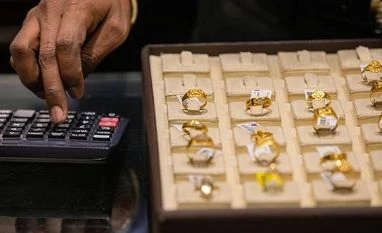Owing to their ability to hedge against inflation, people bought gold, precious stones and art works at a brisk pace during the second quarter (Q2) of 2021-22.
This played a crucial part in jacking up the gross domestic product (GDP) growth. A section of economists say that this indicates the pain the informal economy went through in the quarter but was masked by the headline GDP growth at 8.4 per cent.
These items, called valuables in the national accounts data, crossed the Rs 1-trillion mark even after adjusting for inflation during the second quarter of the current fiscal year. This happened for the first time in recent history.
Expenditure on these items stood at Rs 1.2 trillion, up 183.28 per cent year-on-year (YoY). Compared to the corresponding period of pre-Covid year of 2019-20, valuables rose 170.54 per cent.
The growth rate of valuables was higher at 456.13 per cent during the first quarter of FY22. However, it was mainly because of a very low base of Covid-induced lockdown during the Q1 of 2020-21.
In absolute terms, purchase of valuables was just Rs 17,012 crore during the April-June period of FY22. Compared to the pre-Covid period of 2019-20, purchase of valuables contracted 61.23 per cent during Q1 of FY22.
Without adjusting for inflation, valuables constituted 3.1 per cent of GDP in the second quarter of FY22 whereas it was 1.3 per cent in the corresponding period of the previous year. It accounted for 0.5 per cent of GDP in Q1 of FY22 against 0.1 per cent in the previous year’s April-June period.
Indranil Pan, chief economist at YES Bank, said there is no great joy in 8.4 per cent GDP growth in Q2 of FY22 because that happened due to padding up of valuables. “Had it not happened, the more important items in GDP such as private finance consumption expenditure, government final consumption expenditure and gross fixed capital formation would not have been able to pull that number,” he said.
For the moment, assuming that valuables remained intact at Q2 2020-21 level of Rs 42,253 crore, the GDP growth would have reduced to just six per cent during Q2 of the current fiscal year.
Pan said, “Who is the person who can afford valuables. Part of the savings done because of non-spending on discretionary items due to Covid has gone to valuables. The person on the street is not purchasing these valuables. That is the divide in the economy that is showing up,” he said.
He said this possibly highlights the stark reality of K-shaped recovery, masking the continued pains in the informal sector.
A K-shaped recovery refers to uneven economic growth among different sectors from a previous slump.
He cited a recent survey by Deloitte that showed that Indian consumers are keen to spend on luxuries such as clothing, air travel and vehicles.
“This clearly showed that consumption push is not broad-based across various income categories,” Pan said.
Quarterly GDP data does not fully capture the informal sector and uses various proxies to gauge its activities.
ICRA chief economist Aditi Nayar does not agree with the K-shaped recovery just on the basis of high valuables in the national accounts data. This is because people in rural areas also buy huge quantities of gold, which is one of the most important items in valuables.
Gold imports rose 162 per cent in the second quarter of 2021-22 at $16 billion against $6.1 billion in the corresponding period of 2020-21. Part of this could also be due to hardening of gold prices. However, according to ICRA preliminary estimates, the tonnage of gold imports trebled in Q2 of FY22 compared to Q2 of FY20.
“Possibly, the surge in gold imports represents pent-up demand related to weddings after the reopening, post the second wave of Covid,” she said.
State Bank of India (SBI) group chief economist Soumya Kanti Ghosh said massive jump in valuables imply savings to the tune of two per cent of GDP have moved into precious metals, because of their inflation-hedging property and postponement of marriages during FY21.
Consumer price inflation stood at 5.59 per cent in July and 5.3 per cent in August, but came down drastically to 4.3 per cent in September. However, structural core inflation, which relates to non-food, non-oil items, remained sticky in the range of 5.5-5.9 per cent for over a year now.
People buy valuables in the hope that their value does not erode, rather it appreciates over time.
Unlock 30+ premium stories daily hand-picked by our editors, across devices on browser and app.
Pick your 5 favourite companies, get a daily email with all news updates on them.
Full access to our intuitive epaper - clip, save, share articles from any device; newspaper archives from 2006.
Preferential invites to Business Standard events.
Curated newsletters on markets, personal finance, policy & politics, start-ups, technology, and more.
)